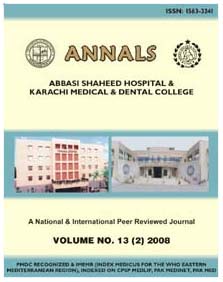
| |
| Home |
| Editorial Staff |
| Instruction to Authors |
| Journal-Issues |
| Policy |
| Copyright |
| WELL BABY VISITS - AN EXPERIENCE IN A
SQUATTER SETTLEMENT OF KARACHI
SHAZIA SHAIKH, HEMNA SIDDIQUI, QUDSIA ANJUM, YOUSUF AHMED, JAWED USMAN ABSTRACT Objective:.To determine the profile of healthy children visiting to the well child clinic in relevance to their growth and development. Design: A cross-sectional study Place and duration of study: The Study was conducted at the Primary Health Care [PHC] center in a squatter settlement of Karachi from December 2003 to December 2004. Methods: A cross-sectional survey of children under 3 years attending the Primary Health Care [PHC] center in a squatter settlement situated near Ziauddin Medical University (ZMU), Clifton. Karachi. It is divided into five blocks with a population of approximately 20,000. It is a low socio-economic area with poor literacy rate. For convenience of follow-up, only those children were enrolled in the well child clinic living within a distance of 5 kms. from the center. The information was recorded on a structured proforma, which included the introduction of the child; natal and pre-natal history; immunization and feeding history; past medical and surgical history; complete general and systemic examination. The growth parameters were recorded on growth chart recommended by the WHO. Results: A total of 62 children were enrolled from birth to 3 years with a mean age and standard deviation of 2.2+1.3 years. Almost half the mothers (34 out of 62) preferred ghutti as a pre-lacteal feed, 6 preferred honey while the rest were unable to remember giving any prelacteal feed. Almost half of the children (n=31) were given colostrum. Breastfeeding was initiated in 18 children while the rest were bottle fed. The weaning age ranged from 4 to 24 months. All the children were fully immunized according to the EPI schedule. Majority of the children were malnourished (82%) and only 18% had normal weight for age according to the growth chart and Gomez's classification. Conclusion: It iwas found in this study that the improved nutrition can lead to improvement in child growth. Keywords: Well child, Malnutrition. Preventive counseling
|
For Full text contact to:
|
|
Department of Family Medicine. Ziauddin Medical University, Karachi, Pakistan
|

Copyright © 2009 Abbbas Shaheed Hospital and Karachi Medical & Dental College.
All rights reserved.
Designed & Developed by: Creative Designers